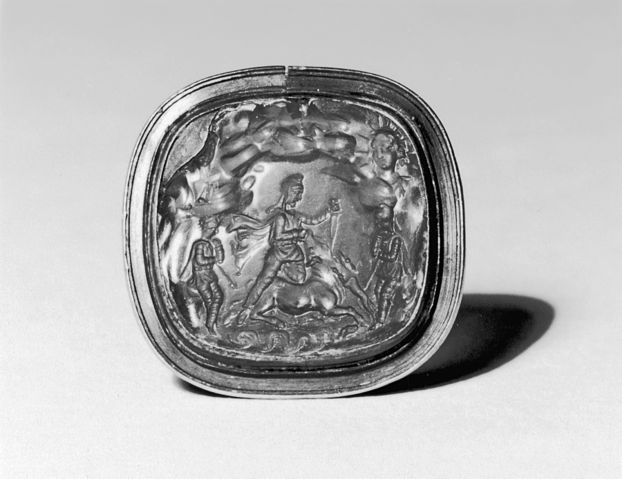
File:Greek - Intaglio of a Mithraic Sacrifice - Walters 421342.jpg

| |
This is a file from the Wikimedia Commons. Information from its description page there is shown below.
Commons is a freely licensed media file repository. You can help. |
Summary
| Artist | Anonymous ( Greece) | |||||||||||||||||
| Title | Intaglio of a Mithraic Sacrifice | |||||||||||||||||
| Description |
English: Mithras was a Persian creation god, as well as the god of light. Mithraism, the mystery religion associated with him, spread throughout the Roman Empire. Initiation into Mithraism was restricted to men and was especially popular with soldiers in Rome and on the northern frontier during the 2nd and 3rd centuries AD.
According to the Persian myth, the sun god sent his messenger, the raven, to Mithras and ordered him to sacrifice the primeval white bull. At the moment of its death, the bull became the moon, and Mithras's cloak became the sky, stars, and planets. From the bull also came the first ears of grain and all the other creatures on earth. This scene of sacrifice, central to Mithraism, is called the Tauroctony and is represented as taking place in a cave, observed by Luna, the moon god, and Sol, the invincible Sun god, with whom he became associated in Roman times. Mithras is generally depicted flanked by his two attendants, Cautes and Cautopates, and accompanied by a dog, raven, snake, and scorpion. In front of the cosmic cave, Mithras, flanked by his two torchbearers, Cautes and Cautopates, sacrifices the primeval bull. He is surrounded by his attributes, a dog, a snake, and the heads of the sun and moon gods. This is a rare early representation of the Tauroctony, and its fine carving and realistic detail differ from later versions of the god's image. |
|||||||||||||||||
| Date | late 1st century BC (Augustan) | |||||||||||||||||
| Medium | sard, gold mount | |||||||||||||||||
| Dimensions | 2.2 × 2.3 × 0.8 cm (0.9 × 0.9 × 0.3 in) | |||||||||||||||||
| Current location |
|
|||||||||||||||||
| Accession number | 42.1342 | |||||||||||||||||
| Credit line | Museum purchase, 1942 | |||||||||||||||||
| Ownership history |
|
|||||||||||||||||
| place of origin | Nemea (?) (in present-day Greece) | |||||||||||||||||
| Source/Photographer | Walters Art Museum: |
|||||||||||||||||
| Permission ( Reusing this file) |
|
|||||||||||||||||
| Error reporting | You can help by reporting errors and typos at Commons:Walters Art Museum/error report. If the error was added by a Wikimedian and is not present on the museum's website, you can fix this page directly, without notifying. |
|||||||||||||||||
Licensing
 |
This file was provided to Wikimedia Commons by the Walters Art Museum as part of a cooperation project. All artworks in the photographs are in public domain due to age. The photographs of two-dimensional objects are also in the public domain. Photographs of three-dimensional objects and all descriptions have been released under the Creative Commons Attribution-Share Alike 3.0 Unported License and the GNU Free Documentation License. In case of the text descriptions, copyright restrictions only apply to longer descriptions which cross the threshold of originality.
|
Object:
| Public domainPublic domainfalsefalse |
 |
This work is in the public domain in the United States, and those countries with a copyright term of life of the author plus 100 years or less. |
|
|
|
Photograph and description:
| This file is licensed under the Creative Commons Attribution-Share Alike 3.0 Unported license. | ||
| Attribution: Walters Art Museum | ||
http://creativecommons.org/licenses/by-sa/3.0 CC-BY-SA-3.0 Creative Commons Attribution-Share Alike 3.0 truetrue |
 |
Permission is granted to copy, distribute and/or modify this document under the terms of the GNU Free Documentation License, Version 1.2 or any later version published by the Free Software Foundation; with no Invariant Sections, no Front-Cover Texts, and no Back-Cover Texts. A copy of the license is included in the section entitled GNU Free Documentation License. http://www.gnu.org/copyleft/fdl.htmlGFDLGNU Free Documentation Licensetruetrue |
File usage
I want to learn more...
All five editions of Schools Wikipedia were compiled by SOS Childrens Villages. SOS Children's Villages helps those who have nothing and no one, giving them back the famly they have lost and bringing them the very best opportunities for a happy, healthy future. Try to find out how you can help children in other countries on our web site.

